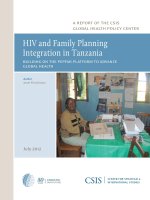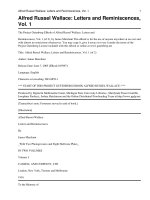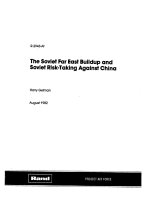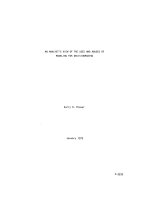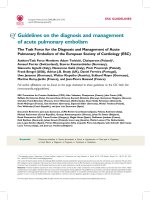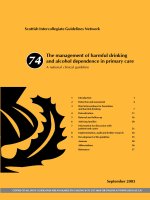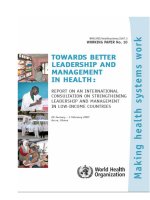Agriculture, fishery and forestry statistics Main results – 2010-11 pot
Bạn đang xem bản rút gọn của tài liệu. Xem và tải ngay bản đầy đủ của tài liệu tại đây (10.22 MB, 228 trang )
Agriculture, fishery
and forestry statistics
Pocketbooks
ISSN 1977-2262
Main results – 2010-11
2012 editionAgriculture, fishery
and forestry statistics
Pocketbooks
Main results – 2010-11
2012 edition
Europe Direct is a service to help you find answers
to your questions about the European Union.
Freephone number (*):
00 800 6 7 8 9 10 11
(*) Certain mobile telephone operators do not allow access
to 00 800 numbers or these calls may be billed.
More information on the European Union is available on the Internet
().
Cataloguing data can be found at the end of this publication.
Luxembourg: Publications Office of the European Union, 2012
ISBN 978-92-79-25431-4
ISSN 1977-2262
doi:10.2785/3341
Cat. No KS-FK-12-001-EN-C
Theme: Agriculture and fisheries
Collection: Pocketbooks
© European Union, 2012
Reproduction of content other than photos is authorised, provided that the
source is acknowledged.
Photo credits: © Phovoir.
Reproduction of photos is allowed for non-commercial purposes and within the
sole context of this publication.
Printed in Belgium
P
RINTED ON ELEMENTAL CHLORINEFREE BLEACHED PAPER (ECF)
3
Agriculture, fishery and forestry statistics
is publication has been produced by Units E1, Agriculture and
sheries, E3, Environment and Forestry, E4, Regional statistics
and geographical information and F5, Education, health and so-
cial protection (food safety).
Authors:
Focus: Common Agriculture Policy: 50 years in 2012 – Catherine
Coyette (Unit E1)
1. Agricultural Census 2010 – Neli Georgieva, Carla Martins (Unit E1)
2. Agricultural accounts and prices – Marco Artico, Jean-Claude
Jeanty, RubenGarciaNuevo, Angelo Milella, Iulia Pop (Unit E1)
3. Agricultural products
• Crop production – Fausto Cardoso, Jean-Claude Jeanty,
Sorina Vâju
• Animal production – Giovanni Dore, Jean-Claude Jeanty,
Pol Marquer (Unit E1)
4. Agriculture and the environment – Annemiek Kremer,
Miroslav Kukucka, Elisabeth Rohner-ielen (Units E1 and F5)
5. Economy of EU rural regions– Pierluigi Brunori, Isabelle
Collet (Unit E4)
6. Fishery – Melina Antuofermo, Annabelle Janssen, Friderike
Oehler (Unit E1)
7. Forestry – Rajmund Laczko, Csaba Mozes, Marlise Wolf–Crowther
(Unit E3)
Coordinator:
Catherine Coyette (Unit E1)
Introduction
4
Agriculture, fishery and forestry statistics
Introduction
e pocketbook Agricultural Statistics presents selected tables and
graphs providing an overview on developments and the situation
in the agricultural sector of the European Union. e most recent
data are presented here (reference years 2010 and 2011, mostly)
showing the situation in the 27 Member States and at the Euro-
pean level (EU-27 aggregates) as well as in EFTA and Candidate
Countries when available.
is pocketbook, intended for both generalists and specialists, is
divided into eight parts.
As 2012 marks the 50
th
birthday of the Common Agricultural Policy
(CAP), for which Eurostat has been providing harmonised statistics
since the beginning, the preliminary chapter provides a selection of
long time series of harmonised agricultural statistics that were used
for the monitoring of the Common Agricultural Policy (CAP).
Chapter 1
presents the results of the last agricultural census at
European level
;
Chapter 2 covers the economy of the agricultural industry and
presents data on output and input values, income indicators and
main price trends;
Chapter 3 presents the most recent data on agricultural production
i.e. meat and milk production, cereals, main crops, fruit and vegetable
production and also some data on vineyards and olive trees;
Chapter 4 provides some important indicators related to the inter-
action between agriculture and the environment;
Chapter 5 presents data on the context of rural development,
making use of the urban-rural typology;
Chapter 6 gives an overview on shery catches, landings of shery
products, aquaculture production and shing eets;
Finally, chapter 8 provides a comprehensive overview of the most
recent data on Forestry.
More detailed data as well as methodological information can be
found on the Eurostat website at:
/>is website oers free access to the Eurostat’s dissemination da-
tabase, predened tables, methodological documents and other
publications of Eurostat.
Introduction
Table of contents
5
Agriculture, fishery and forestry statistics
Table of contents
Introduction 4
Focus on the Common Agricultural Policy:
50 years in 2012 9
Farm structure 12
Land use 14
Crop production 14
Animal production 16
Agricultural accounts 19
1 – Agricultural Census 2010 – Structural data 21
Methodological notes 24
1.1 Agricultural holdings 26
1.2 Land use 34
1.3 Livestock 37
1.4 Economic size 40
1.5 Labour force 49
1.6 Organic farming 54
2 – Agricultural accounts and prices 57
Introduction 59
2.1 Agricultural income 60
2.2 Final output 68
2.3 Inputs 71
2.4 Agricultural labour input 73
2.5 Price indices 75
3 – Agricultural Products 81
3.1 Crop production 83
3.2 Livestock and meat production 100
3.3 Milk and milk products 108
4 – Agriculture and the environment 115
4.1. Cropping and livestock patterns 117
4.2. Organic farming 125
5 – Economy of EU rural regions 129
Introduction 131
5.1 e urban-rural typology 132
5.2 Gross domestic product per inhabitant
in EU rural regions 135
Table of contents
Table of contents
6
Agriculture, fishery and forestry statistics
5.3 GDP per inhabitant by urban-rural typology
as compared with the national average 137
5.4 GDP per inhabitant by urban-rural typology
as compared
with the EU average 138
5.5 Trend of GDP per inhabitant
between 2000 and 2009 140
5.6 Contribution of the value added
by urban-rural typology 141
5.7 Contribution of the rural regions
to the gross value added 142
6 – Fishery 145
6.1 Total production 148
6.2 Aquaculture production 150
6.3 Catches 153
6.4 Landings 158
6.5 Fishing Fleet 162
7 – Forestry and the wood-based industry 167
Introduction 169
7.1 Macroeconomic indicators 170
7.2 Forestry and logging 175
7.3 e wood-based industry 184
Units, abbreviations and symbols used
7
Agriculture, fishery and forestry statistics
Units, abbreviations and symbols used
Units
ha hectare=10 000 m²
kg kilogram
KgOE Kilograms of oil equivalent
KTOE ousandtonnes of oil equivalent
t tonne
Abbreviations
AEI Agri-environmental indicators
AWU Annual work unit
EAA Economic accounts for agriculture
ESA European System of Accounts
FADN Farm Accountancy Data Network
FAO Food and Agriculture Organization of the United Nations
FSS Farm Structure Survey
GHG Greenhouse Gas emissions
GIP Gross indigenous production
GNB Gross Nitrogen Balance
GVA Gross value added
GWP Global Warming Potential
LD Livestock density
LSU Livestock unit
LFS Labour Force Survey
MS Member State
NUTS Nomenclature of territorial units for statistics
OECD Organisation for Economic Co-operation and Development
OGA Other gainful activity
SGM Standard Gross Margin
UAA Utilised agricultural area
EU European Union
EU-27 European Union of 27 Member States
EU-15 European Union of 15 Member States
BE Belgium
BG Bulgaria
CZ Czech Republic
DK Denmark
DE Germany
EE Estonia
IE Ireland
EL Greece
ES Spain
Units, abbreviations and symbols used
Units, abbreviations and symbols used
8
Agriculture, fishery and forestry statistics
FR France
IT Italy
CY Cyprus
LV Latvia
LT Lithuania
LU Luxembourg
HU Hungary
MT Malta
NL Netherlands
AT Austria
PL Poland
RO Romania
PT Portugal
SI Slovenia
SK Slovak Republic
FI Finland
SE Sweden
UK United Kingdom
IS Iceland
LI Liechtenstein
NO Norway
CH Switzerland
HR Croatia
Symbols
c Condential data
u Uncertain data
– Not applicable
0.0 Less than half the unit used
: Not available
( ) Small sample size may aect the reliability of the data
Italic gures Estimated values
Focus on the Common
Agricultural Policy:
50 years in 2012
Focus on the Common Agricultural Policy: 50 years in 2012
11
Agriculture, fishery and forestry statistics
e EEC Common Agricultural Policy, foreseen in the Treaty of
Rome, was enacted in 1962. 2012 marks the 50
th
anniversary of
this key element of European integration. e initial objectives of
the CAP were to improve agricultural productivity in order to pro-
vide aordable food to all European citizens and a fair standard of
living for farmers by means of guaranteed prices. During the past
50 years the CAP has seen several reforms. e support to agri-
cultural products prices, leading to over-production of food prod-
ucts, evolved towards a greater market orientation. Taking also
the EU citizens concerns into account, the PAC also widened its
scope, focusing on environmentally-friendly farming, food safety,
animal welfare and rural development.
Agricultural statistics were designed to monitor the main objec-
tives of the CAP since the late 1950’s. Indeed, proper management
of the CAP required the availability of harmonised data on farm
structure, agricultural production, prices and income. Since then,
European decision-makers made use of Eurostat agricultural sta-
tistics to properly design, implement, monitor and evaluate the
dierent CAP programmes.
In order to ensure harmonisation and comparability of data be-
tween Member States, statistical surveys and regulations were de-
signed and implemented over years, ensuring the use of common
denitions and methodologies among the Member States.
e rst Community survey on the structure of agricultural hold-
ings took place in 1966/67, soon followed by an agricultural cen-
sus (full scale survey) in 1970/71. ese surveys are still the basis
of the agricultural statistics system nowadays. Indeed, the last ag-
ricultural census took place in 2010 (see chapter 2).
Other legislative texts were put in place aerwards, covering sur-
veys on agricultural sectors for which statistics were needed for
decision making (milk and milk products survey, crop products
survey, orchard survey, vineyard survey, etc.).
An overview of the current agricultural statistics legislation is
available on Eurostat website: Agricultural Satistics – Legislation.
e gures presented in this chapter show how agricultural pro-
duction has evolved in 50 years and how the European Union
became a major player at world level.
Focus on the Common Agricultural Policy: 50 years in 2012
Focus on the Common Agricultural Policy: 50 years in 2012
12
Agriculture, fishery and forestry statistics
Farm structure
Table 1: Number of agricultural holdings, 1966-2010
(1 000)
1966/67
6 MS
1970
6 MS
1980
9 MS
1990
12 MS
2000
15 MS
2010
27 MS
EC/EU (
1
) 6404.9 5888.3 5821.4 7993.0 6770.7 11966.4
BE (
2
) 214.8 184.0 115.1 85.0 61.7 42.9
BG 370.5
CZ 22.9
DK 122.7 81.3 57.8 42.1
DE 1 246.0 1 074.6 849.9 653.6 472.0 299.1
EE 19.6
IE : 223.5 170.6 141.5 139.9
EL : 850.1 817.1 674.9
ES : : 1 593.6 1 287.4 989.8
FR 1 708.0 1 587.6 1 255.3 923.6 663.8 516.1
IT 2 980.5 2 849.9 2 832.4 2 664.6 2 153.7 1 620.9
CY 38.9
LV 83.4
LT 199.9
LU (
2
) 8.6 7.6 5.2 4.0 2.8 2.2
HU 576.8
MT 12.5
NL 247.0 184.6 148.7 124.8 101.6 72.3
AT 199.5 150.2
PL 1 506.6
PT 598.7 416.0 305.3
RO (
2
) 3 859.0
SI 74.7
SK 24.5
FI 81.2 63.9
SE 81.4 71.1
UK (
2
) 268.6 243.1 233.3 186.7
(
1
) EC/EU: aggregate calculated for the countries being Member States in the reference year.
(
2
) 2010: provisional data for BE, LU, RO, UK.
Source: Eurostat (online data codes: ef_kvecsleg and ef_ov_kvaaesu and historical data)
Focus on the Common Agricultural Policy: 50 years in 2012
13
Agriculture, fishery and forestry statistics
Table 2: Total labour input, 1966-2010
(1 000 AWU)
1966/67
6 MS
1970
6 MS
1980
9 MS
1990
12 MS
2000
15 MS
2010
27 MS
EC/EU (
1
) 10120.0 7461.0 7599.2 8024.3 6352.7 9736.1
BE (
2
) 272.0 189.0 124.0 93.5 74.1 61.6
BG 406.5
CZ 108.0
DK 122.7 95.2 66.5 52.3
DE 2 330.0 1 611.0 850.2 1 030.0 617.6 545.5
EE 25.1
IE : 223.5 249.7 168.5 165.4
EL : 998.9 680.3 587.5 404.3
ES : : 1 143.4 1 077.7 889.0
FR 3 032.0 2 369.0 1 255.3 1 256.5 949.4 779.7
IT 4 127.0 2 990.0 2 832.6 1 924.0 1 364.9 953.8
CY 18.6
LV 85.2
LT 146.8
LU (
2
) 17.0 12.0 5.2 6.3 4.5 3.7
HU 423.5
MT 4.9
NL 342.0 290.0 148.8 225.0 205.1 161.7
AT 181.9 114.3
PL 1 897.2
PT : 769.4 846.9 524.2 363.4
RO (
2
) 1 610.3
SI 76.7
SK 56.1
FI 102.6 59.7
SE 74.2 56.9
UK (
2
) 268.6 473.7 354.3 266.3
(
1
) EC/EU: aggregate calculated for the countries being Member States in the reference year.
(
2
) 2010: provisional data for BE, LU, RO, UK.
Source: Eurostat (online data codes: ef_kvecsleg and ef_ov_kvaaesu and historical data)
Focus on the Common Agricultural Policy: 50 years in 2012
14
Agriculture, fishery and forestry statistics
Land use
Figure 1: Utilised agriculture area (UAA) and total area in EC / EU (
1
),
1962-2010
(1 000 ha)
50 000
100
000
150
000
200
000
250
000
300
000
350
000
400
000
450
000
1962 1970 1980 1990 2000 2010
Total land area UAA
(
1
) EC/EU: aggregate calculated for the countries being Member States in the reference year.
Source: Eurostat (online data code: apro_cpp_luse);
Crop production
Figure 2: EC / EU (
1
)
harvested production of main cereals,
1962-2010
(1 000 tonnes)
0
20
000
40
000
60
000
80
000
100
000
120
000
140
000
160
000
1962 1970 1980 1990 2000 2010
WheatBarleyMaize Rye and maslin
(
1
) EC/EU: aggregate calculated for the countries being Member States in the reference year.
Source: Eurostat (online data code: apro_cpp_crop);
Focus on the Common Agricultural Policy: 50 years in 2012
15
Agriculture, fishery and forestry statistics
Figure 3: Share of wheat production between main world
producers, 2010
(%)
China
18
%
India
12
%
USA
9
%
Russian Federation
6 %
Pakistan
4
%
Canada
4
%
Australia
3
%
Turkey
3
%
Ukraine
3
%
Rest of the world
17
%
21
%
EU-27
Source: Eurostat (online data code apro_cpp_crop) and FAO
Figure 4: Share of wheat production between main world
producers, 1962
(%)
Spain
2
%
Argentina
2
%
Australia
3
%
Turkey
3
%
India
5
%
Canada
6
%
Rest of the world
21
%
USSR
27
%
USA
12
%
EU-6
12
%
China
7
%
Source: Eurostat (online data code apro_cpp_crop) and FAO
Focus on the Common Agricultural Policy: 50 years in 2012
16
Agriculture, fishery and forestry statistics
Animal production
Table 3: Apparent yield from cow’s milk collection, EC / EU (
1
),
1970-2011
(kg/dairy cow/year)
1970
6 MS
1980
9 MS
1990
12 MS
2000
15 MS
2010
27 MS
2011
27 MS
EC / EU (
1
) 2 809.5 3 623.8 4 236.1 5 733.0 5 859.0 6 051.0
BE 2 656.0 3 139.1 3 791.7 4 963.5 5 924.3 6 077.2
BG 1 748.9 1 626.5
CZ 6 172.1 6 324.5
DK 4 612.6 5 906.4 7 018.6 8 408.4 8 267.7
DE (
2
) 2 826.7 3 273.7 3 725.2 5 912.9 6 853.4 7 002.0
EE (
2
) 6 466.3 6 534.0
IE 3 144.5 3 984.3 4 476.1 5 187.0 5 245.9
EL 2 207.0 3 088.9 4 777.8 4 907.7
ES 2 857.1 4 762.4 6 899.3 7 456.1
FR 2 409.7 3 500.1 4 580.9 5 605.7 6 283.2 6 690.3
IT 2 133.8 2 652.9 3 763.5 5 690.7 5 960.7 5 846.2
CY 6 453.0 6 348.5
LV 3 808.7 4 034.1
LT 3 552.0 3 768.2
LU 3 258.1 3 665.2 4 625.9 5 871.6 6 130.4 6 314.6
HU 5 531.4 5 155.4
MT : : : : : :
NL 4 080.0 4 885.4 5 601.5 6 887.1 7 658.8 7 730.7
AT 4 275.4 5 220.6 5 506.3
PL 3 554.2 3 800.3
PT 3 768.4 5 266.4 7 500.0 7 590.9
RO 764.5 797.5
SI 4 739.7 4 821.3
SK 5 022.0 5 262.8
FI 6 823.1 8 051.4 8 010.7
SE 7 743.1 8 204.2 8 199.1
UK 3 656.3 4 720.5 5 033.4 5 956.4 7 354.6 7 668.9
(
1
) EC/EU: aggregate calculated for the countries being Member States in the reference year.
(
2
) DE 1970 and 1980 and Estonia 2010: estimated data.
Source: Eurostat (online data codes: apro_mk_cola and apro_mt_lscatl)
Focus on the Common Agricultural Policy: 50 years in 2012
17
Agriculture, fishery and forestry statistics
Figure 5: Share of cow’s milk production between main world
producers, 2010
(%)
EU-27
23
%
USA
15
%
India
8
%
China
6
%
Russian
Federation
5
%
Brazil
5
%
New Zealand
3
%
Turkey
2 %
Pakistan
2
%
Ukraine
2
%
Rest of the world
29
%
Source: Eurostat (online data code: apro_mk_cola) and FAO
Figure 6: Share of cow’s milk production between main world
producers, 1970
(%)
USSR
23
%
Rest of the world
26
%
Turkey
2
%
New Zealand
2
%
Brazil
2
%
Australia
2
%
Canada
2
%
India
2
%
Poland
4
%
USA
15
%
EU-6
20
%
Source: Eurostat (online data code: apro_mk_cola) and FAO
Focus on the Common Agricultural Policy: 50 years in 2012
18
Agriculture, fishery and forestry statistics
Figure 7: Slaughterings of bovine animals in EC / EU (
1
)
(young and adult cattle)
(1 000 tonnes, 1 000 heads)
0
5
000
10
000
15
000
20
000
25
000
30
000
1964 1970 1980 1990 2000 2010 2011
1 000 T1 000 heads
(
1
) EC/EU: aggregate calculated for the countries being Member States in the reference year.
Source: Eurostat (online data codes: apro_mt_pann and apro_mt_pheadm)
Focus on the Common Agricultural Policy: 50 years in 2012
19
Agriculture, fishery and forestry statistics
Agricultural accounts
Table 4: Agricultural income indicator (indicator A), 1977-2011
(2005 = 100)
1977
9 MS
1980
9 MS
1985
10 MS
1990
12 MS
1995
15 MS
2000
15 MS
2005
25 MS
2010
27 MS
2011
27 MS
EC/EU (
1
)
: : : : 106.1 105.7 100.0 111.5 119.1
BE : 100.2 116.3 129.5 101.9 119.1 100.0 141.1 109.3
BG : : : : : : 100.0 123.5 152.2
CZ : : : : : : 100.0 129.3 160.0
DK 81.3 77.1 112.4 106.3 124.4 104.9 100.0 113.8 136.7
DE (
2
) : : : : 64.0 90.1 100.0 113.2 128.7
EE (
2
) : : : : : : 100.0 156.9 188.7
IE : : : 65.5 87.1 98.3 100.0 79.6 101.5
EL : : : : 131.5 117.8 100.0 83.5 78.9
ES : : : 88.7 98.3 104.4 100.0 99.0 97.5
FR 70.8 72.6 74.5 94.8 108.3 110.2 100.0 116.0 113.7
IT : 107.7 101.2 101.3 116.1 117.9 100.0 79.9 88.7
CY : : : : : : 100.0 92.0 93.5
LV : : : : : : 100.0 134.5 148.0
LT : : : : : : 100.0 120.8 144.8
LU : : 93.8 115.7 112.4 110.8 100.0 61.5 76.7
HU : : : : : : 100.0 123.2 183.8
MT : : : : : : 100.0 89.9 77.3
NL : : : 170.6 147.3 127.0 100.0 112.7 102.6
AT : : : : 95.4 89.6 100.0 106.5 123.7
PL : : : : : : 100.0 161.7 175.9
PT : : : 95.0 113.9 107.6 100.0 96.6 86.7
RO : : : : : : 100.0 87.7 137.5
SI : : : : : : 100.0 100.9 106.0
SK : : : : : : 100.0 114.4 133.9
FI : : : : 99.2 94.5 100.0 129.0 121.7
SE : 80.3 73.2 86.5 80.2 81.8 100.0 122.4 123.9
UK 113.0 92.4 90.9 92.8 137.4 78.8 100.0 138.8 150.4
(
1
) EC/EU: aggregate calculated for the countries being Member States in the reference year.
Source: Eurostat (online data code: aact_eaa06);
Indicator A is the index of the real income of factors in agriculture
per annual work unit.
Agricultural Census 2010 –
Structural data
1Agricultural Census 2010 – Structural data
23
Agriculture, fishery and forestry statistics
e Farm Structure Survey provides harmonized data on the on
the structure of agricultural holdings in the European Union, in
particular on land use, livestock and farm labour force. Every ten
years since 1970 a basic survey is carried as an agricultural census.
ree intermediate surveys are conducted between two basic ones,
i.e. with an interval of two or three years. ey are conducted as
sample surveys in most of the MS.
In this year’s edition of the pocket book the focus is on the results
of the 2010 FSS, giving an overview of the main characteristics of
the European agriculture structure, and comparing the national
results of the Agricultural Census.
FSS 2010 was the rst Agricultural Census to be carried out simul-
taneously in all EU-27 Member States, Norway and Switzerland.
In Croatia the FSS 2010 was carried out as a sample survey. e
FSS 2010 national surveys cover 98 % of Utilized Agricultural Area
(UAA) and 98 % of the livestock in each country.
A threshold is dened under which a unit is too small to be count-
ed as an agricultural holding (e.g. 1hectares of UAA, a minimum
of 5 pigs, 50 m
2
under glass or 100 m
2
under vineyard). Each Mem-
ber State denes its own set of thresholds in order to meet the
targeted coverage. is means that the smallest farms (under the
threshold) are not surveyed.
To obtain the 98 % coverage of the UAA and the Livestock most
countries set the threshold to include farms with a UAA over 1 ha.
e Czech Republic, Denmark, Germany, Sweden and the United
Kingdom are exceptions, having set the thresholds to the maxi-
mum allowed in the FSS 2010: 5hectares.
Agricultural Census 2010 – Structural data
